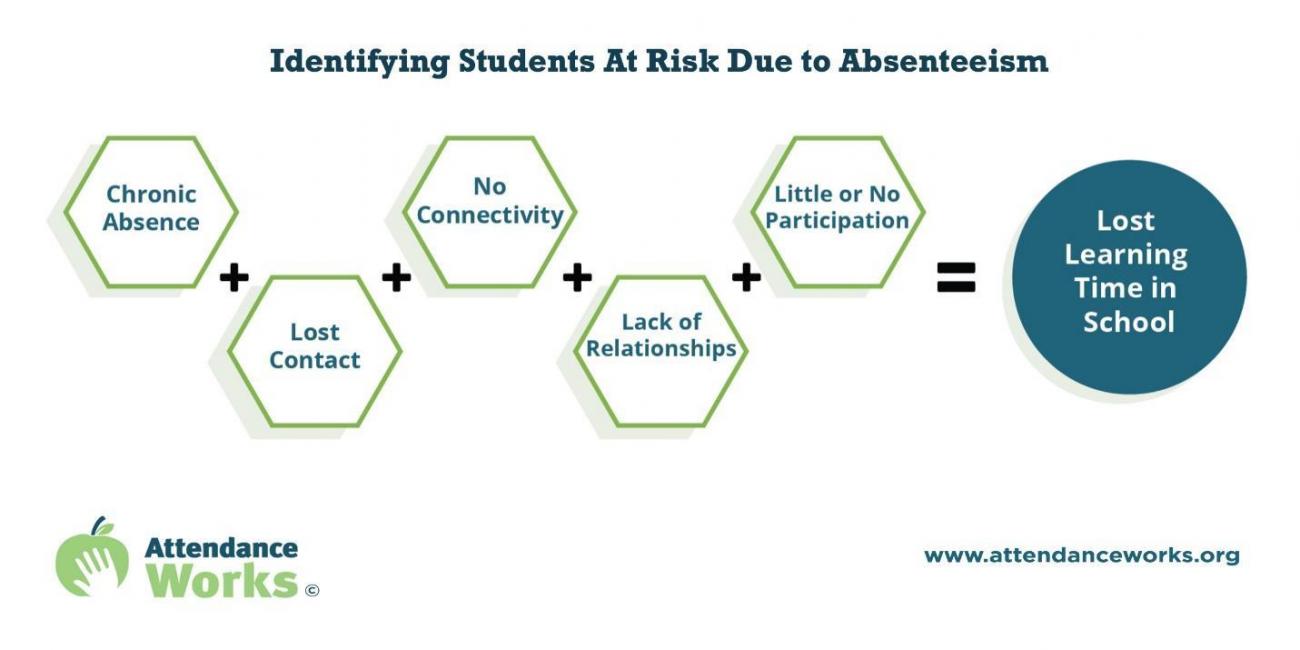Measuring Daily Attendance and Participation During COVID-19

Why Attendance Matters
With COVID-19, taking daily attendance and monitoring absenteeism is essential. Absenteeism is a leading indicator of educational inequity. A wealth of research shows chronic absence (missing 10% or more of the school year) predicts being less likely to read proficiently by third grade, pass courses in middle school, or graduate from high school.
When students don't “show up” to school (whether it is in person, at distance, or blended), it is an early warning sign that positive conditions of learning (physical and emotional health and safety; a sense of belonging; an affirming environment; connection and support; academic challenge and engagement; and adults and peers with the capacity to support these conditions) are not in place for students, their families, and sometimes their entire community. This is as true for preschoolers as it is for young adults. If absenteeism is widespread, it is an indication of challenges that require systemic solutions.
Monitoring absences helps schools and their partners take action early to improve attendance and notice who is missing out on opportunities to learn before students fall further behind. Given the projected learning loss from school closures this spring, it is more imperative now than ever that students are present every day.
California’s Learning Continuity Attendance Plan
Although many educators stopped taking attendance last spring due to the challenges of responding to the pandemic, the legislature recognized the importance of taking daily attendance and measuring participation in distance learning with the passage of Senate Bill 98. Key provisions include:
- Local educational agencies (LEAs) must continue taking daily attendance for days in which students are in the school building and must document daily participation for each pupil during distance learning.
- A pupil who does not participate in distance learning on a school day is documented as absent for that school day.
- Daily participation may include, but is not limited to, evidence of participation in online activities, completion of regular assignments, completion of assessments, and contacts between employees of the LEA and pupils or parents or guardians.
- Each LEA shall ensure that a weekly engagement record is completed for each pupil documenting participation.
- If students miss more than three school days or 60 percent of the instructional days in a week, LEAs must take a tiered approach to re-engagement that includes verifying contact Information, notifying parents or guardians of absences,and having a plan for outreach to determine pupil needs—including connection with health and social services as necessary.
These provisions recognize that maintaining attendance data provides schools with timely early feedback about whether, at a minimum, the instruction being offered is reaching students. It also can provide parents and guardians basic knowledge about whether their children are participating in learning activities.
Challenges to Measuring Attendance and Participation
While taking attendance is more complicated in the context of distance learning, it is still possible. To make attendance-taking even more useful for educators in assessing factors affecting student participation, Attendance Works advocates a multi-metric framework that encourages educators to ask themselves key questions, including:
- Are any students already at risk because they experienced chronic absence prior to school closures?
- Can we contact students and families?
- Do students have the technology needed to access virtual instruction?
- Are we building relationships and a sense of connection with students and their families?
- Are students showing up for the learning activities offered?
Answering these questions helps identify which students are at risk and what might be preventing them from attending school. See the Supporting Learning in the Context of COVID-19 report (pp. 11–12) for a description of one district’s attendance dashboard from spring 2020.

Different metrics call for different responses. If working contact information isn’t available, then a school or district may need to invest in creative outreach strategies such as the ones in these tips. Many districts are already working to address connectivity by finding resources, including from business partners or municipalities, to provide internet access and issue devices. Relationships, or the lack of them, may be addressed through formal or informal mentoring programs or opportunities to participate in peer to-peer-activities such as clubs. If none of these challenges explain the situation, then a school can focus on better understanding what is causing a lack of participation. Perhaps the instruction being offered isn’t engaging, a family member has become ill, or the family is struggling to find employment and maintain stable housing. Determining these causes will prompt yet different actions.
Until new research examining absenteeism in blended or distance learning settings can be conducted, we advise continuing to monitor which and how many students miss 10% or more of “learning opportunities.” A learning opportunity is an instructional or learning activity that takes place in person or during synchronous or asynchronous distance learning. Attendance should be taken for each learning opportunity and absence rates calculated by dividing the total number of missed learning opportunities by the total number of learning opportunities offered.
For example, in one week of school, a student has the opportunity to participate in twenty learning opportunities: ten synchronous distance learning sessions, six in-person sessions, and the submission of four asynchronous assignments. Missing three of these would mean missing fifteen percent. This is similar to tracking secondary school period attendance in many districts.
School teams can then use data on absence rates to identify students who need support. This can also equip districts to monitor for equitable access to learning across schools, grades, and key populations of students, including for different racial and ethnic groups, students with disabilities, English learners, and students experiencing homelessness or in foster care.
Recommendations for Action for Local Education Agencies and the California Department of Education
- Pay attention to how many and which students miss the first week of school! This is an early indication that a school needs enhanced communications and additional outreach to understand why they aren’t showing up.
- Publish chronic absence data from 2019–20 through school building closure by district, school, grade, and student population so partners can identify where to target additional supports.
- Collect and report on the percent and number of students without working contact information by zip code, race/ethnicity, disability, economic status, and whether the student is experiencing homelessness or is in foster care.
- Collect and report on the percent and number of students who lack connectivity (internet access and devices) including by zip code, race/ethnicity, disability, economic status, and whether the student is experiencing homelessness or in foster care.
- Offer guidance about how to collect data for asynchronous learning (e.g., submitting an assignment, completing a survey, logging time on a learning management system).
- Track attendance/participation by mode of instruction (i.e., in person, synchronous, or asynchronous). Compare absences across different modes of instruction to gain insights into what might be affecting attendance.
- Produce absenteeism data (the number and percent of students who missed 10% or more of all learning opportunities) by school, grade, and student sub-population over the course of the school year.
- Offer guidance for what activates tiered supports during distance learning, including who can and should take action and what resources can be offered to support students and families.
Measuring attendance and participation is now more essential than ever. While this is foundational, it is only a first step towards ensuring we are creating engaging and equitable learning experiences that help all of our students thrive and succeed.
Read the related commentary A Tiered Approach to Ensuring Students are Present, Engaged, and Supported in the 2020–21 School Year here.
Hedy Chang is Executive Director and Cecelia Leong is Vice President of Programs at Attendance Works, which focuses on advancing student success to help close equity gaps by reducing chronic absence.
Chang, H., & Leong, C. (2020, August 4). Measuring daily attendance and participation during COVID-19: An invaluable tool for reducing educational inequity [Commentary]. Policy Analysis for California Education. https://edpolicyinca.org/newsroom/measuring-daily-attendance-and-participation-during-covid-19



